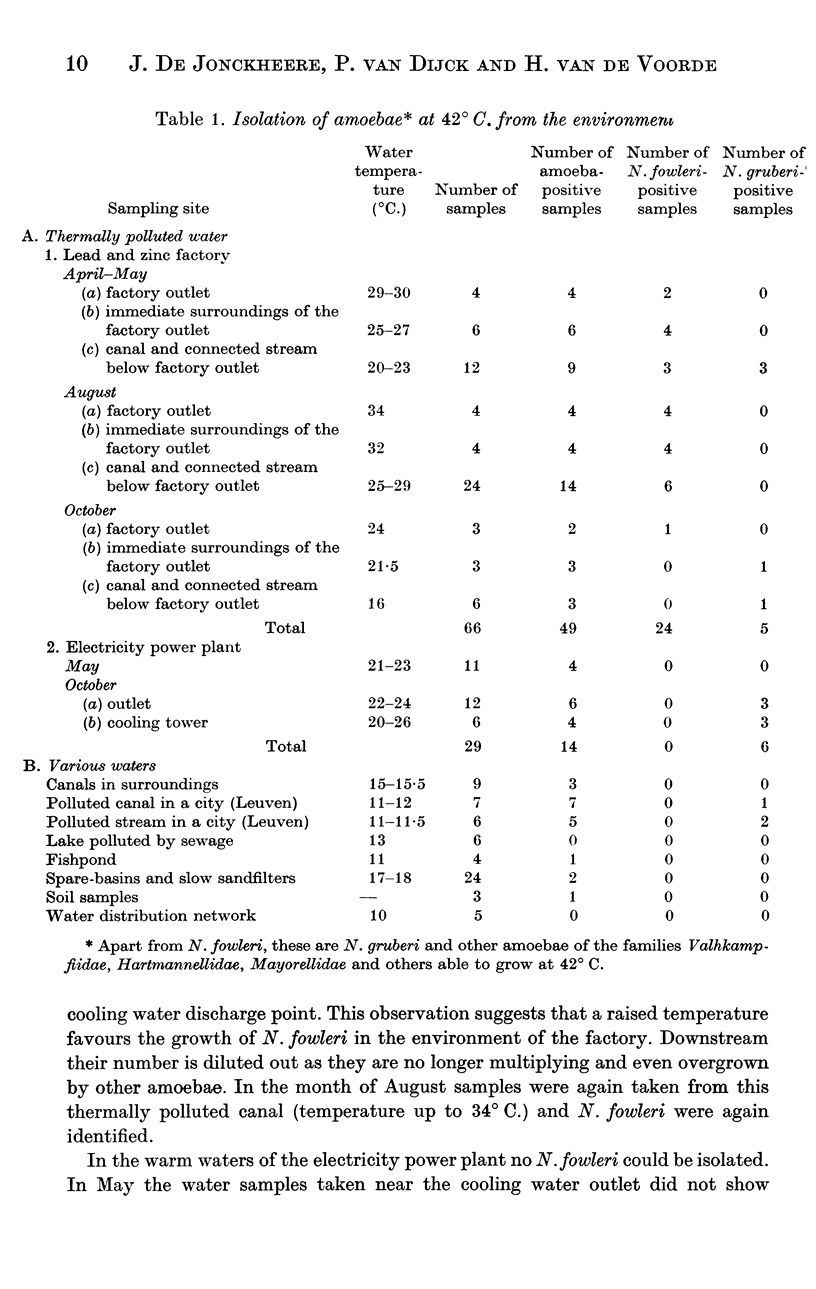Abstract
The distribution in the environment of Naegleria fowleri, the causal agent of primary amoebic meningoencephalitis has been investigated in this study. N. fowleri was isolated only from a thermally polluted canal. These amoebaflagellates were not isolated from another thermally polluted canal in the neighbourhood indicating that, apart from high temperature, other factors are involved in the selective proliferation of N. fowleri. This species was absent in all other samples originating from two canals, a stream, two lakes, several reservoirs and slow sandfilters of a water supply service and also a water distribution network. Many other amoebae able to grow at 42 degrees C. were found in different places. Most of the N. fowleri strains isolated were not virulent for mice, although they showed all the characteristics of the pathogenic strains.
Full text
PDF






Selected References
These references are in PubMed. This may not be the complete list of references from this article.
- Anderson K., Jamieson A. Primary amoebic meningoencephalitis. Lancet. 1972 Apr 22;1(7756):902–903. doi: 10.1016/s0140-6736(72)90772-6. [DOI] [PubMed] [Google Scholar]
- Carter R. F. Primary amoebic meningo-encephalitis. An appraisal of present knowledge. Trans R Soc Trop Med Hyg. 1972;66(2):193–213. doi: 10.1016/0035-9203(72)90147-2. [DOI] [PubMed] [Google Scholar]
- De Jonckheere J., Van Dijck P., Van de Voorde H. Evaluation of the indirect fluorescent-antibody technique for identification of Naegleria species. Appl Microbiol. 1974 Aug;28(2):159–164. doi: 10.1128/am.28.2.159-164.1974. [DOI] [PMC free article] [PubMed] [Google Scholar]
- Duma R. J., Rosenblum W. I., McGehee R. F., Jones M. M., Nelson E. C. Primary amoebic meningoencephalitis caused by Naegleria. Two new cases, response to amphotericin B, and a review. Ann Intern Med. 1971 Jun;74(6):923–931. doi: 10.7326/0003-4819-74-6-923. [DOI] [PubMed] [Google Scholar]
- Griffin J. L. Temperature tolerance of pathogenic and nonpathogenic free-living amoebas. Science. 1972 Nov 24;178(4063):869–870. doi: 10.1126/science.178.4063.869. [DOI] [PubMed] [Google Scholar]
- Jadin J. B., Hermanne J., Robyn G., Willaert E., Stevens W., Van Maercke Y. Trois cas de méningo-encéphalite amibienne primitive observés a Anvers (Belgique. Ann Soc Belges Med Trop Parasitol Mycol. 1971;51(2):255–266. [PubMed] [Google Scholar]
- Jadin J. M., Eschbach H. L., Verheyen F., Willaert E. Etudes comparatives des kystes de Naegleria et d'Acanthamoeba. Ann Soc Belg Med Trop. 1974;54(4-5):259–264. [PubMed] [Google Scholar]
- Mandal B. N., Gudex D. J., Fitchett M. R., Pullon D. H., Malloch J. A., David C. M., Apthorp J. Acute meningo-encephalitis due to amoebae of the order myxomycetale (slime mould). N Z Med J. 1970 Jan;71(452):16–23. [PubMed] [Google Scholar]
- Page F. C. Taxonomic criteria for limax amoebae, with descriptions of 3 new species of Hartmannella and 3 of Vahlkampfia. J Protozool. 1967 Aug;14(3):499–521. doi: 10.1111/j.1550-7408.1967.tb02036.x. [DOI] [PubMed] [Google Scholar]
- Van den Driessche E., Vandepitte J., Van Dijck P. J., De Jonckheere J., Van de Voorde H. Letter: Primary amoebic meningoencephalitis after swimming in stream water. Lancet. 1973 Oct 27;2(7835):971–971. doi: 10.1016/s0140-6736(73)92634-2. [DOI] [PubMed] [Google Scholar]
- Visvesvara G. S., Callaway C. S. Light and electron microsopic observations on the pathogenesis of Naegleria fowleri in mouse brain and tissue culture. J Protozool. 1974 May;21(2):239–250. doi: 10.1111/j.1550-7408.1974.tb03648.x. [DOI] [PubMed] [Google Scholar]


